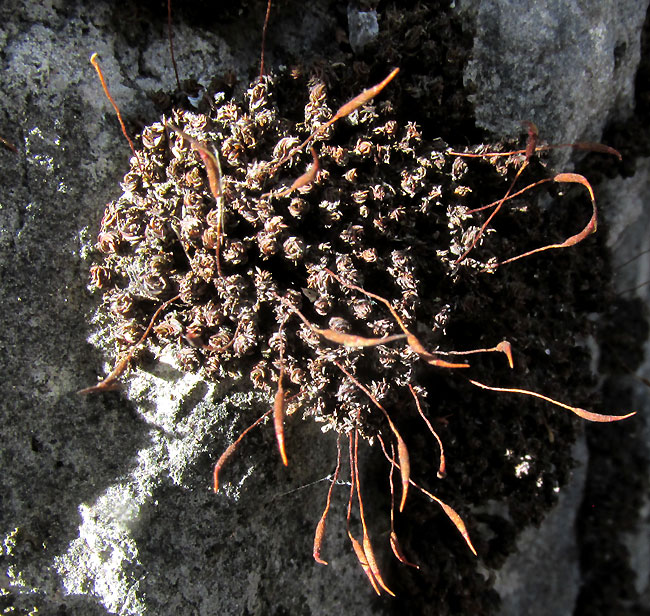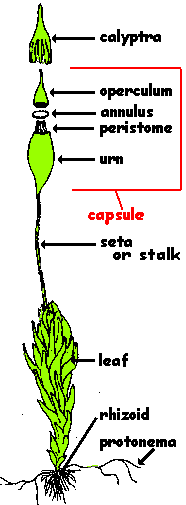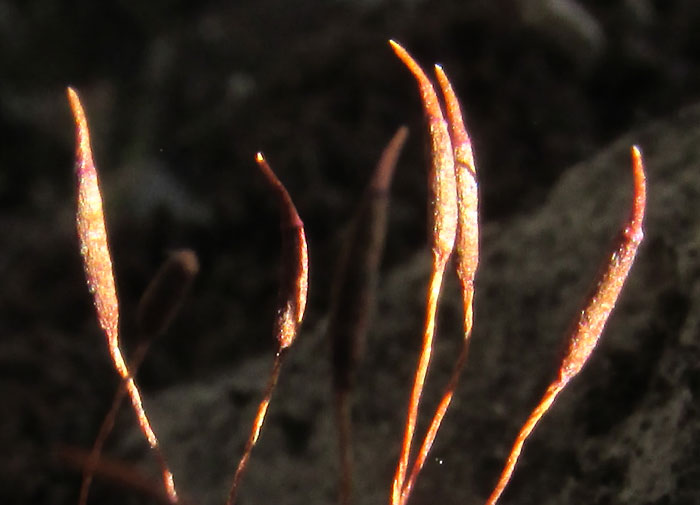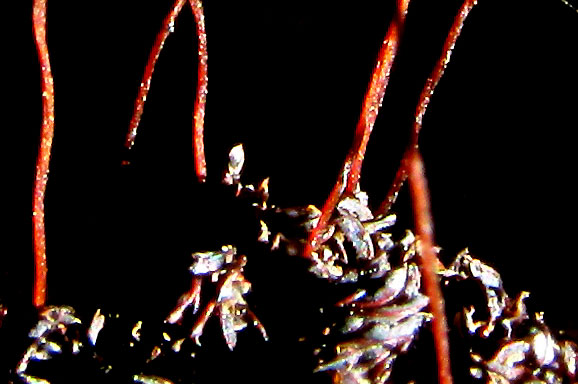Excerpts from Jim Conrad's
Naturalist Newsletter
entry from field notes dated April 17, 2022, taken in disturbed/reforesting borderline cloudforest within 1km of Valle de los Fantasmas, elevation ±2,320m (7600 ft), with limestone bedrock; about 40kms (24 miles), straight-line, ESE of San Luis Potosí, San Luis Potosí state, MÉXICO, (N22.06°, W100.62°)
BROOM MOSS


Here and there atop this north-south-running mountain range overlooking the vast flatlands to the west, the main highway between San Luis Potosí city and Río Verde cut through limestone. On a certain limestone rock on a north-facing slope the above tuft-forming moss had found home.
This is a fairly arid region, but at this elevation westerly winds off the flatlands rise, cool off, humidity in the air condenses, and often this valley is filled with fog/cloud. Taking advantage of the humid air, mosses and lichens grow on trees and rocks. Most mosses seen now during the latter part of the dry season bear no reproductive structures but this tuft did. At the right, a review of moss reproductive structure may help you appreciate the following pictures.
In bright sunlight and dry wind, this tuft's individual moss bodies are curled into themselves to conserve water by exposing less surface area, so it's hard to see the leaves. However, even at this distance the slender, curved, brown, spore-containing capsules topped with even slenderer, long-pointed, dunce-cap-shaped calyptras already provide important field marks. These can better be admired below:

The capsules are seen closer below:

In some moss genera the capsules are spherical, or they broaden toward their tops. Often they don't curve. The above capsules' general shape, size and color help very much during the identification process. Also the leaves' features are important:

Usually I can't identify mosses to species level unless there's a microscope handy. However, leaves on this particular species displayed important features seen by the naked eye and with a hand lens.
The fact that the moss bodies clumped into a dense, mound-like tuft is important, for many species don't do that. In the picture, note how many of the leaves, especially a little to the right of the image's bottom-center, appear to be "swept" to one side, as if by the wind. Those same leaves are very slender and gradually taper to sharp points, but there's no needle-like "awns" at the tips. Each leaf is curved, and has a prominent midrib that grows broader toward the base. In the picture, leaf blades look silvery, but I'm unsure what color they were. The sunlight was so intense that everything was too contrasty, all black and white. Another important feature barely showing on two or three leaves is that the leaf margins are finely toothed, or serrated. The serrations are too small for the image to show clearly, but you can see them if you look hard.
All these features led me to a fairly large group of mosses embracing about 140 species found globally, the genus Dicranum. Sometimes Dicranum species are referred to generally as "wind-blown mosses," because of the "swept-to-one-side" appearance noted above.
Delgadillo Moya C's 2016 online publication "Los musgos de México," "The Mosses of Mexico," lists 917 species documented at that time in Mexico. It's made clear that Mexico's mosses aren't well studied so other species may have been added since then. Six Dicranum species are listed. When online pictures and technical descriptions of each of those species are consulted, only one species appears to agree with the all details noted above, and that's DICRANUM SCOPARIUM.
The Flora of North America says that Dicranum scoparium is called Broom Moss because its leaves are “swept” or turned in the same direction. The species extends over a large area of distribution, from arctic North America south through Mexico to northern South America, plus Eurasia, even with reports from Australia. Moreover the species is adaptable enough to inhabit wet bogs, decaying logs, swamps, humus atop rocks, and tree trunks in dry to mesophytic forests. The Flora says nothing about its living on limestone, but on the Internet collections can be found of them from limestone rocks, as with Snider #301, CINC Herbarium.
Without having access to a microscope, especially in an area not well studied, it's impossible to be sure of a moss identification just by comparing pictures and word descriptions. However, with all the above evidence, especially the "swept-to-one-side" leaves, Dicranum scoparium seems to be a good bet.